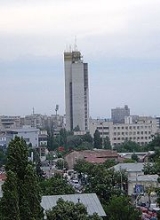
Giulesti
Encyclopedia

Bucharest
Bucharest is the capital municipality, cultural, industrial, and financial centre of Romania. It is the largest city in Romania, located in the southeast of the country, at , and lies on the banks of the Dâmbovița River....
, in Sector 6. The Giuleşti Stadium
Giulesti Stadium
Giuleşti-Valentin Stănescu Stadium is a football stadium in Bucharest, Romania and is the home stadium of Rapid Bucureşti.The stadium is named after Valentin Stănescu, the coach that helped Rapid to win its first title, but it is still commonly known as the "Giuleşti Stadium", after the name of the...
, Giuleşti Theatre, Podul Grant
Podul Grant
Podul Grant is a bridge for motorway and lightrail in Bucharest, Romania. It is named after Effingham Grant, the British consul in Bucharest in the mid-19th century. Initially, the bridge was made of steel, and opened in 1910. In the late 1970s, it was remade from concrete...
are located in Giuleşti. Also, the Griviţa
Grivita
Griviţa is an area of Bucharest, Romania, centered on the Griviţa Railway Yards , which were and still are an important landmark within the manufacturing landscape of the city...
Railway Yards and Lacul Morii are located nearby.
The Giulesti Stadium
Giulesti Stadium
Giuleşti-Valentin Stănescu Stadium is a football stadium in Bucharest, Romania and is the home stadium of Rapid Bucureşti.The stadium is named after Valentin Stănescu, the coach that helped Rapid to win its first title, but it is still commonly known as the "Giuleşti Stadium", after the name of the...
(officially "Valentin Stănescu") is the home of Rapid Bucureşti soccer club, one of the best teams in Romania.
The area was inhabited for millennia and it gives its name to the neolithic Giuleşti-Boian culture, the middle phase of the Boian culture
Boian culture
The Boian culture , also known as the Giuleşti-Marica culture or Marita culture, is a Neolithic archaeological culture of Southeast Europe...
, which inhabited in the 4th millennium BC
4th millennium BC
The 4th millennium BC saw major changes in human culture. It marked the beginning of the Bronze Age and of writing.The city states of Sumer and the kingdom of Egypt were established and grew to prominence. Agriculture spread widely across Eurasia...
Muntenia
Muntenia
Muntenia is a historical province of Romania, usually considered Wallachia-proper . It is situated between the Danube , the Carpathian Mountains and Moldavia , and the Olt River to the west...
and later expanded into southern Moldavia
Moldavia
Moldavia is a geographic and historical region and former principality in Eastern Europe, corresponding to the territory between the Eastern Carpathians and the Dniester river...
and southern Transylvania
Transylvania
Transylvania is a historical region in the central part of Romania. Bounded on the east and south by the Carpathian mountain range, historical Transylvania extended in the west to the Apuseni Mountains; however, the term sometimes encompasses not only Transylvania proper, but also the historical...
.
In the Middle Ages it was a village, later incorporated into Chiajna
Chiajna
Chiajna is a commune in the south-west of Ilfov County, Romania, immediately west of the capital, Bucharest. It is composed of three villages: Chiajna, Dudu and Roşu.-Etymology:Chiajna is a Romanian female name, being a feminine version of "cneaz" ....
Commune, and absorbed into Bucharest in 1939.

